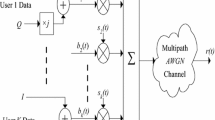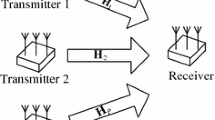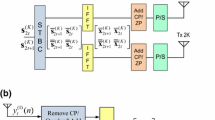Abstract
In this paper blind channel estimation methods for long code CDMA system with multicode transmission are proposed. By allocating multiple codes, higher data rates may be provided to a user. Blind channel estimation allows reducing pilot signaling. Hence, higher effective data rates may be achieved and larger sample support may be obtained by using both the information symbols and known pilot symbols for channel estimation. Algorithms are extended to multi-antenna receiver which further improves the performance. The performance of the algorithms is studied in extensive simulations using WCDMA system model. The effects of code selection, interference and noise, number of antennas, antenna correlation are considered using frequency selective channel models. The proposed methods are more robust in the face of interference and code selection than the well-known subspace method in [7]. The computational complexity is lower as well.
Similar content being viewed by others
References
T. Ojanperä and R. Prasad, Wideband CDMA for Third Generation Mobile Communications, Wiley, 1998.
H. Holma, A. Toskala, WCDMA for UMTS, Wiley, 2000.
“Physical layer aspects of UTRA High Speed Downlink Packet Access”, Technical Report 3GPP TR 25.858, Version 5.0.0, 3GPP, March 2002.
V. Koivunen, J. Laurila and E. Bonek, “Blind Methods for Wireless Communication Receivers”, Review of Radio Science 1999-2002, John Wiley & Sons, pp. 247–273, 2002.
L. Tong and S. Perreau, “Blind Channel Estimation: From Subspace to Maximum Likelihood Methods”, Proceedings of IEEE, Vol. 86, No. 10, pp. 1951–1968, 1998.
H. Liu, G. Xu and L. Tong, “Recent Developments in Blind Channel Equalization: From Cyclostationary to Subspaces”, Signal Processing, Vol. 50, Nos. 1–2, pp. 83–99, 1996.
A.J. Weiss and B. Friedlander, “Channel Estimation for DS-CDMA Downlink with Aperiodic Spreading Codes”, IEEE Transactions on Communications, Vol. 47, No. 10, pp. 1561–1569, 1999.
H. Liu and M.D. Zoltowski, “Blind Equalization in Antenna Array CDMA Downlink Systems”, IEEE Transactions on Signal Processing, Vol. 45, No. 1, pp. 161–172, 1997.
Recommendation ITU-R M.1225, “Guidelines for Evaluation of Radio Transmission Technologies for IMT-200”, Questions ITU-R 39/8, 1997.
Lucent, Nokia, Siemens and Ericsson, “A Standardized Set of MIMO Radio Propagation Channels”, Technical Report R1-01-1179, 3GPP TSG-RAN WG1, November 2001.
C.J. Escudero, U. Mitra and D.T.M. Slock, “A Toeplitz DisplacementMethod for BlindMultipath Estimation for Long Code DS/CDMA Signals”, IEEE Transactions on Signal Processing, Vol. 49, No. 3, pp. 6654–665, 2001.
E. Moulines, P. Dyhamed, J.-F. Cardoso and S. Mayargue, “Subspace Methods for Blind Identification of Multichannel FIR Filters”, IEEE Transactions on Signal Processing, Vol. 43, No. 2, pp. 516–525, 1995.
A.J. Paulraj, D. Gesbert and C. Papadis, “Smart Antennas for Mobile Communications”, in Encyclopedia for Electrical Engineering, John Wiley & Co., 2000.
B. Jiang, X. Wu and Q. Yin, “Blind Space-Time Channel Estimation with Aperiodic Spreading Code”, in Proc. IEEE 53rd Vehicular Technology Conference, VTC'01 Spring, Rhodes, Greece, May 2001, pp. 1362–1366.
E. Aktas and U. Mitra, “Complexity Reduction in Subspace Based Channel Identification for DS/CDMA Systems”, IEEE Transactions on Communications, Vol. 48, No. 8, pp. 1392–1404, 2000.
J.G. Proakis, Digital Communications, McGraw-Hill: New York, 1995.
J. Saltz and J.H. Winters, “Effect of Fading Correlation on Adaptive Arrays in Digital Mobile Radio”, IEEE Transactions on Vehicular Technology, Vol. 43, No. 4, pp. 1049–1057, 1994.
“Spreading and Modulation (FDD)”, Technical Report 3G TS 25.1213, 3GPP TSG-RAN WG1, December 1999.
D.G. Brennan, “Linear Diversity Combining Techniques”, Proc. IRE, 1959, Vol. 47, pp. 1075–1102, 1959.
M. Melvasalo and V. Koivunen, “Blind Channel Estimators in Multicode CDMA System with Antenna Arrays”, in Second IEEE Sensor Array and Multichannel Signal Processing Workshop, Washington D.C., U.S.A., August 2002.
Author information
Authors and Affiliations
Rights and permissions
About this article
Cite this article
Melvasalo, M., Koivunen, V. Blind Channel Estimation in Multicode CDMA Using Multiantenna Receiver. Wireless Personal Communications 28, 163–178 (2004). https://doi.org/10.1023/B:wire.0000032251.56954.9f
Issue Date:
DOI: https://doi.org/10.1023/B:wire.0000032251.56954.9f




